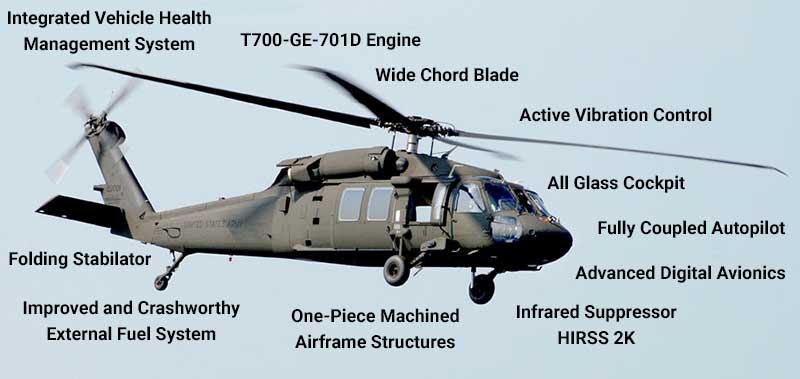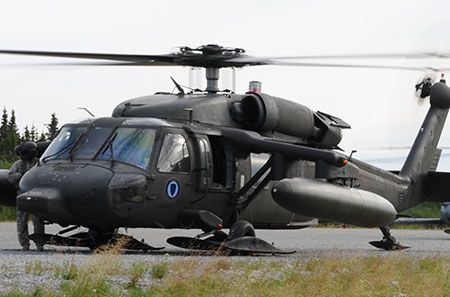Professional Insights: Enhancing Effectiveness in UH 60 Helicopter Operations
Professional Insights: Enhancing Effectiveness in UH 60 Helicopter Operations
Blog Article
Understanding the Mechanics and Design Behind Uh 60 Helicopters
The UH-60 helicopter, typically recognized as the Black Hawk, stands as a pinnacle of modern-day rotorcraft technology, embodying a blend of robust design and elaborate auto mechanics. As we peel off back the layers of the UH-60's layout, a world of elaborate systems and precise design comes to light.
History of UH-60 Helicopters
The background of UH-60 helicopters traces back to the late 1970s when the USA Army sought a advanced and flexible utility helicopter to change its aging fleet. In action to this requirement, the Sikorsky Aircraft Corporation developed the UH-60 Black Hawk helicopter. Presented in 1979, the UH-60 rapidly ended up being a staple in armed forces operations due to its excellent abilities.
The UH-60 was developed to excel in a range of missions, including troop transport, clinical evacuation, digital warfare, and special procedures. Its capability to adapt to various functions made it a valuable property to the united state Military and various other military pressures worldwide
Throughout the years, the UH-60 system has actually undergone numerous upgrades and variations to enhance its performance and maintain pace with progressing objective needs. These helicopters have actually seen comprehensive service in conflicts such as the Gulf Battle, Afghanistan, and Iraq, showcasing their reliability and convenience in varied operational atmospheres. The UH-60's abundant background is a testimony to its enduring heritage as a leading utility helicopter.

Engine and Power Systems
Using sophisticated propulsion modern technology, UH-60 helicopters are geared up with sophisticated engine and power systems to make certain optimal performance and dependability in a variety of operational situations. The UH-60, commonly referred to as the Black Hawk, is powered by 2 General Electric T700-GE-701D engines, each qualified of delivering up to 1,940 shaft horsepower. These turboshaft engines provide the essential thrust for the helicopter to bring out its objectives efficiently, consisting of army transportation, clinical evacuation, and combat assistance.

Blades System and Aerodynamics
How do the rotor system and aerodynamics of UH-60 helicopters contribute to their functional efficiency and flight abilities? The blades system of the UH-60 helicopter plays a vital duty in providing lift and propulsion.
The rules of aerodynamics also play a key function in the performance of UH-60 helicopters. The structured fuselage and rotor blade layout reduce drag, enabling the helicopter to achieve higher speeds and better our website fuel efficiency. The wind resistant layout of the UH-60 additionally contributes to its capability to run in diverse ecological conditions, consisting of warm temperatures and high altitudes.
Avionics and Flight Control Solution

In its intricate coordination with the blades system and aerodynamics of UH-60 helicopters, the avionics and flight control systems form a vital network of technologies forming the aircraft's operational capabilities. Avionics encompass the electronic systems used for interaction, navigating, and keeping an eye on numerous hop over to here airplane functions. In the UH-60, these systems consist of electronic display screens, communication radios, GPS navigating, climate radar, and autopilot systems. These avionics systems offer important details to the pilots, improving situational recognition and ensuring effective and risk-free operation of the helicopter.
The trip control systems of the UH-60 are in charge of converting the pilot's inputs right into the ideal changes to the rotor system, making sure secure flight and ability to move. These systems consist of hydraulic actuators, servos, and computer systems that interact to manage the major and tail blades, in addition to other trip control surfaces. By specifically handling the helicopter's trip dynamics, these systems enable pilots to carry out a wide variety of objectives, from transport and search-and-rescue to combat procedures, with precision and self-confidence.
Role and Applications in Aviation
The role and Continued applications of avionics and trip control systems in aviation are integral to making certain the effective and risk-free operation of aircraft, consisting of UH-60 helicopters. Avionics systems in UH-60 helicopters encompass a series of electronic systems that aid in navigating, interaction, surveillance, and regulating various airplane functions. These systems consist of digital displays, autopilot systems, communication radios, general practitioner navigation tools, and weather radar. Trip control systems play a vital function in maneuvering the helicopter in the air, maintaining security, and guaranteeing accurate motions. The fly-by-wire technology used in modern-day UH-60 helicopters equates pilot inputs into electronic signals, which are after that translated by the flight control computer systems to readjust the aircraft's control surface areas. In addition, these systems include security features such as auto-pilot settings, terrain recognition advising systems, and stability augmentation systems to enhance the overall safety and operational capabilities of the UH-60 helicopters in numerous missions, consisting of army transportation, medical evacuation, search and rescue, and airborne firefighting.
Conclusion
In verdict, the UH-60 helicopter is a flexible airplane with a rich history and progressed engineering. Its engine and power systems, rotor system, the rules of aerodynamics, avionics, and trip control systems all work together to make it a effective and reputable equipment.
In its intricate control with the blades system and the rules of aerodynamics of UH-60 helicopters, the avionics and trip control systems create a crucial network of technologies forming the airplane's functional capacities.The flight control systems of the UH-60 are accountable for translating the pilot's inputs into the suitable adjustments to the rotor system, ensuring secure trip and maneuverability. Avionics systems in UH-60 helicopters incorporate an array of digital systems that aid in navigating, interaction, tracking, and controlling numerous aircraft features. In addition, these systems integrate safety attributes such as autopilot modes, surface understanding cautioning systems, and security enhancement systems to enhance the general safety and functional abilities of the UH-60 helicopters in various goals, including troop transport, clinical emptying, search and rescue, and airborne firefighting.
Its engine and power systems, rotor system, the rules of aerodynamics, avionics, and flight control systems all work with each other to make it a trustworthy and efficient machine.
Report this page